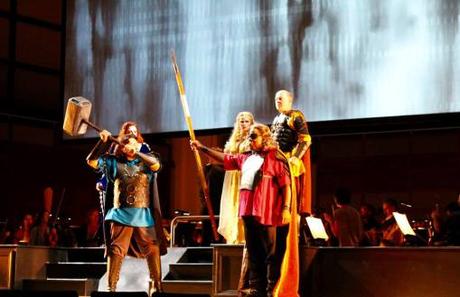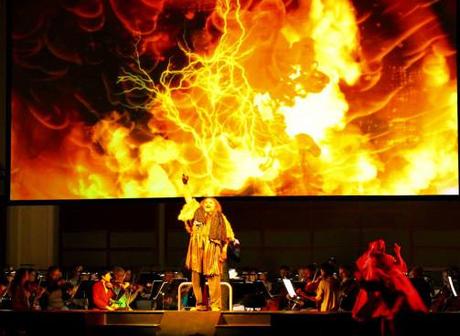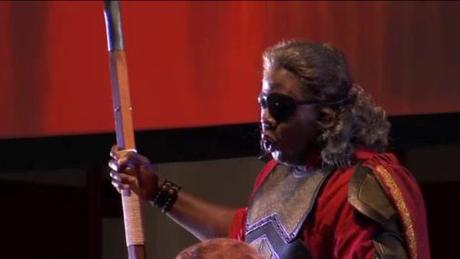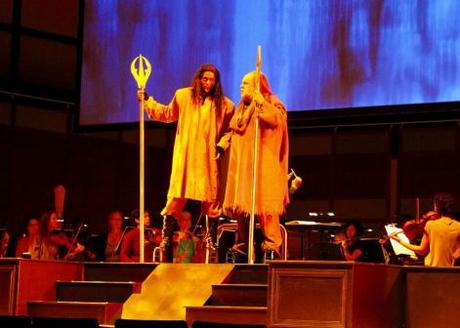Clever by a Half
 Alberich (Todd Thomas) & the Rhine Maidens, in rehearsal for Scene I of Wagner’s Das Rheingold (Photo: North Carolina Opera)
Alberich (Todd Thomas) & the Rhine Maidens, in rehearsal for Scene I of Wagner’s Das Rheingold (Photo: North Carolina Opera)
Instead of presenting Das Rheingold in one long, continuous take as Wagner originally intended, North Carolina Opera inserted a composer-sanctioned intermission at the spot where Loge, the god of fire and stealth, leads Wotan through a crevice and down into Nibelheim, the land of the dwarfs.
The moment is marked in the score with the pounding of twelve “anvils,” tuned, of course, to a variety of musical notes. The noise these specially constructed instruments make fade in and fade out, as if our protagonists had simply passed by and waved “hello” on their way to Alberich’s lair.
If continuity be damned, we can consider ourselves fortunate that this brief interruption did little to prevent the drama from unfolding and attaining its stated purpose. With this semi-staged version of Das Rheingold, North Carolina Opera, or NCO for short, has now joined the exalted ranks of opera companies that can boast of a high-quality introduction to Wagner’s Ring. I was privileged to catch their Sunday matinee performance of September 18, given in the acoustically sound Meymandi Concert Hall in downtown Raleigh.
The production was directed by James Marvel, with sponsorship by C. Thomas Kunz, NCO’s Board Chairman. The projections designer was S. Katy Tucker (who also worked on Francesca Zambello’s Ring production at Washington National Opera) , with lighting designs by Jax Messenger, costumes by Denise Schumaker, and wig and makeup designs by Sondra Nottingham. The stage manager was Linda T. Carlson, with English captions the work of Jonathan Dean (courtesy of Seattle Opera, © 2011). Incidentally, those pounding anvils — only eight of them were utilized for this production — were underwritten by the LORD Corporation.
The eighty-person strong North Carolina Opera Orchestra (including two harpists and four trained Wagner tuba players) was planted onstage, with a movie screen hovering in front of and above the playing platform. This was done in order to provide a showcase for the ever-changing palette of hi-tech projections, done in the digital realm. These projections were timed to follow the action, curtailed somewhat by the limited performing space, and in sync with Wagner’s musical requirements. Such was the ideal. The execution, for the most part, reflected the ambitions of both NCO’s General Director Eric Mitchko and Artistic and Music Director Timothy Myers.

No doubt, the hero of the two-hour-and-forty-five-minute affair has been, and continues to be throughout his seven-year tenure with NCO, the talented young maestro Tim Myers. We need look no further than the opening E-flat prelude, which first resounds in the double basses, the orchestra’s lowest pitched instruments, for clues as to where this performance would go. Grounded in the Earth itself, this prelude depicts the creation of all matter and all things. One by one, the other sections join in — horns, strings, woodwinds — in a constant reiteration of the Rhine River motif. The ebb and flow of the score, capturing the endless cycle of life and repeating itself over the course of the entire work in intertwining variations, was beautifully articulated in Myers’ deferential treatment of the piece.
Having fully recovered from the traffic accident that nearly sidelined his earlier appearance in last season’s concert performance of Tchaikovsky’s Eugene Onegin (see the following review: https://josmarlopes.wordpress.com/2016/03/12/tchaikovsky-in-the-triangle-eugene-onegin-in-concert-at-north-carolina-opera-part-two/), Myers led a fast-paced, seamlessly sculpted reading of the first in Wagner’s monumental The Ring of the Nibelung tetralogy. The orchestra was never rushed, not even in the concluding moments when bombast and pomp can sometimes overwhelm the proceedings.
Myers strived to bring out Wagner’s delicate filigree of instrumentation, for example, in the lovely figures that follow the Rhine Maidens’ floating about the stage; in the blustery passages depicting the excursion to Nibelheim; and in the exquisite violin interlude that takes over after Alberich has hurled his imprecation at the gods for stealing the Ring from his person. Each of these musical cues was given a fair amount of time to make their effectiveness felt. One can’t say enough about Myers’ ability to elicit such noteworthy outpourings from NCO’s orchestra. He can consider his contribution to this venture a triumph of method over means.
The Good, the Bad, and Everybody Else

His work with the singers proved even more revelatory, particularly in the tricky Rhine Maiden episode that begins the saga. Most conductors skirt over this sequence in practice, but not Myers. Thanks to fine ensemble work from Rachel Copeland, Kate Farrar, and Deborah Nansteel (as the mermaids Woglinde, Wellgunde, and Flosshilde, respectively), this scene, which can lead to boredom and monotony in lesser mortals, was deftly handled from start to finish.
Hampered only by the awkward stage platform, set up to resemble the Metropolitan Opera’s 45-ton, 24-plank monstrosity known as “The Machine,” these three artists overcame the general clumsiness of flitting about the stage (trying to pretend they were “swimming” in the waters of the Rhine) to deliver a seriocomic tour de force of Scene i of Wagner’s epic. The Maidens “reappeared” vocally at the end, lamenting the loss of the Ring of power, as the roof-rattling Valhalla theme reverberated prominently in the brass.
Baritone Todd Thomas, previously associated in the past with Italian opera and Verdi, made a splash with the audience for his riveting, generally gratifying assumption of Alberich, the unintended heavy of the piece. I say “unintended” mostly because the brute’s biggest problem is his longing to experience passion and love. It’s not his fault he was born an ugly old dwarf. Little people suffer enough indignities in real life. Why do they have to suffer them in fictional stories as well? No matter, Thomas took his time to warm up to the challenge of his predecessors, Gustav Neidlinger and Zoltán Kelemen, in this fabulous part. Today, bass-baritones Eric Owens and Samuel Youn own the role of Alberich, although Thomas gained strength vocally and histrionically as the plot evolved and proceeded to its inevitable conclusion.
I must say that Thomas’ bite was as mean and nasty as his bark. His gnarly tone and physically disheveled appearance added immeasurably to the sympathetic portrait he created of the jilted “lover” Alberich. His Curse was bone-chilling in its delivery, and his anguish at having lost his prized possession drew cheers at the end for the effort he mustered to bring this much maligned character to life. It’s a shame that Alberich’s time onstage is diminished with each succeeding chapter in the cycle. By the time we get to Götterdämmerung, there is little left of his persona except in a nightmarish dream sequence in which Alberich appears to his evil son, Hagen, at the outset of Act II.
Leading the way in Scene ii, bass-baritone Alfred Walker made for a sturdy Wotan. The quality of the voice is obvious, and of Porgy and Bess proportions to boot. He only needs a more nuanced facility with the words and clearer emotional connection to the text to become a first-rate interpreter. We may be in the presence of the next generation’s most eloquent Wotan, but I do digress. I am eager to hear him in Act II of Die Walküre, should the powers that be at North Carolina Opera decide on staging that portion of the cycle in the near future. As it is, Walker’s sound and fury signaled a turning point in the casting of this part. He has already sung the Dutchman in Wagner’s Der fliegende Holländer, as well as Amfortas in the same composer’s Parsifal. With his background and experience in this repertoire, then, it was evident that Walker would be able to draw from these two assignments a more lyrical head god than has been the norm of late.

Wotan’s first address to the newly built fortress of Valhalla, “Vollendet das ewige Werk,” was solid and smooth. Walker’s voice remained potent throughout the afternoon, as it rang out gloriously during the intervals where Wotan called Donner’s attention for his belligerence, as well as his final apostrophe before crossing the Rainbow Bridge (“Folge mir, Frau! In Walhall wonne mit mir”). I thought he might have needed a shade more heft in finding his way around the cumbersome staging. Perhaps better projection of the text might have helped make his words felt in the vast open spaces of Meymandi Hall. Still, this was as fine an attempt at portraying the head god as a flawed leader as any I have encountered of late.
Trying her best to take Wotan’s head out of the clouds was mezzo-soprano Michaela Martens’ mellow-voiced and womanly Fricka. Based on her previous appearances with the Met, especially as Marilyn Klinghoffer in the polemical The Death of Klinghoffer by John Adams, Martens was a natural for the harried housewife, taking the approach that the goddess of hearth and home, and of all that we humans hold sacred within the bonds of matrimony, need not be a haranguing harpy in order to get her way. The role, both here and in Die Walküre, is woefully short in comparison to Wagner’s other mezzo leads, including Venus in Tannhäuser, Ortrud in Lohengrin, Brangäne in Tristan, and Kundry in Parsifal. Nevertheless, the regal bearing is there, along with Martens’ projection of the text. Stage-wise, there really wasn’t much for Fricka to do except to coddle her younger sister Freia from the clutches of those fearsome giants, Fasolt and Fafner.
Speak of the devils both artists were absolutely above reproach. British basso Richard Wiegold as Fasolt and American Solomon Howard as Fafner made for a solidly acted team of brothers in no one’s arms. They successfully delineated the two characters in appearance, bearing, and tone: Wiegold, with his excellent German diction, booming voice, and prominent stance (they each wore six-inch clodhoppers), showed heart-on-sleeve compassion for the fair Freia, whom he has fallen hopelessly in love with; while Solomon, the more (heh, heh) “practical-minded” of the pair, stressed treachery and the lust for gold as the main reason for holding the goddess hostage.
Vocally, Wiegold would make an outstanding Hunding and Hagen. Large-scaled and robust, and fully capable of sustaining the high tessitura of his role’s demanding range Wiegold gave a star-in-the-making performance. For his part, Solomon showed why he is one of the newer generation’s most outstanding young artists to emerge in this repertoire. Bravo to both of you fine gentlemen!

As the trickster Loge, tenor Richard Cox, a veteran of Robert Lepage’s Ring project at the Met (he sang the minor part of Froh), was particularly convincing. His narrations in Scene ii were all projected with lithe tone and slippery carriage, an all-but ideal imitation of a lighter-than-air being. When volume was called for, Cox was able to fling his finely focused instrument ahead of the orchestra, no mean feat when given the NCO’s potency.
The same could be said for Adam Lau’s Donner, who used his supple bass-baritone to sculpt a volatile thunder god, willing and able to swing his papier-mâché hammer directly at an adversary’s scull. More bulk was needed in Lau’s call to the mists, however (“Heda, Heda, Hedo!”), and the flimsy manner in which his hammer hit the rock was a lost opportunity. For the best recorded example of thunder and clamor in this scene, take out your copy of Sir Georg Solti’s Decca/London/Polygram Das Rheingold album for a thrill of a lifetime.
Vale Rideout as a whining, sniveling Mime, Maryann McCormick as Erda, Wade Henderson as Froh, and Hailey Clark as Freia, all contributed to the general excellence of the proceedings. Each stood out in their way to lend believability to their assignments. McCormick’s “walk on” as the Earth Mother, though, would have been laughable had the part been sung in an America’s Got Talent manner. Fortunately, we were treated to an appealingly flowing discourse, slow and measured and in keeping with the number’s portentous nature.
And now, a word on those digital projections. In some respects they served the story well, for example, near the beginning as the world was being created and the exciting light show during the call to the mists. Also, the color scheme worked to the production’s benefit when the primary color “yellow” stood in for the stolen gold. In other aspects, such as the itty bitty frog and the monstrous serpent that Alberich turns himself into, they left this viewer cold. The projection of Valhalla was a hit, as was the rainbow bridge. However, the gods crossing that same bridge evoked snickers in the audience due to their slow-motion glide over the stage.
There was also a bit of confusion back and forth as both gods and giants made their entrances and exits. Fasolt’s slaying at the hands of his brother Fafner was unconvincing at best. In all, there wasn’t enough of a playing area for the singers and story to develop and expand upon. This was the same criticism I launched at the Met Opera’s failed Ring cycle production, i.e., the lack of serviceable space. The end result was nowhere near the trouble it took to have merited the labor and expense of placing those planks on the Met Opera stage. Thankfully, NCO was spared the embarrassment of the Met’s boondoggle.
Copyright © 2016 by Josmar F. Lopes

